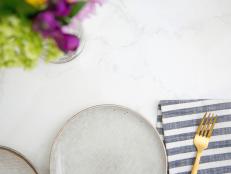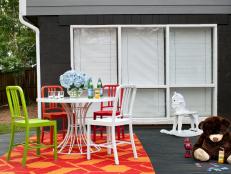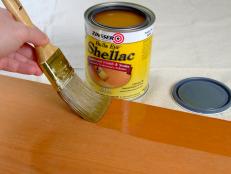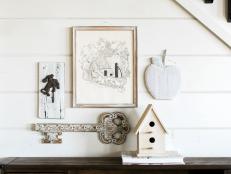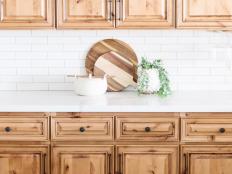Decorative Paint Technique: Woodgraining Instructions

Difficulty level: 2.5 out of 5
Danielle's Tips
Always practice on a primed/base-coated sample board. Strie is also called dragging. Wood-graining tools are available online or at your local paint store.
Materials and Tools:
wood-graining tool
door
paintbrushes
220-grit sandpaper
rags
plastic containers
paint tray
china bristle brushes
latex glaze (Studio Finishes 405); latex paint, eggshell sheen (base coat: Bryant Gold HC-7), (wood-toned colors: Clinton Brown HC-67, Hasbrouck Brown HC-71) – Benjamin Moore
blue painter's tape
artists brushes
putty knife
water-based wax (fauxlikeapro.com) or acrylic varnish
Steps:
1. Prime and base-coat the door, sanding it lightly once dry and removing the dust with a damp rag between layers. In separate containers, mix one part of each wood-toned color with one part water and one part glaze.
2. It's important to paint in the direction of the wood grain so tape-off the horizontal (including mitered) edges of the trim. Make sure to push the tape down really well so paint doesn't bleed underneath.

3. Wood graining is actually the strie technique with a new step added. Apply a small amount of the Clinton Brown mixture as you would for strie with long, straight horizontal strokes (figure A). Some areas will be a little darker and some lighter, which is fine and enhances the natural feel of wood. Let dry.

4. For the second coat, apply a light, streaky coat of the Hasbrouck Brown mixture, and while it's still wet, drag and rock the wood-graining tool through it to create the knots and grain found in wood (figure B). Use the edges of the tool to create different looks. If an area looks a little too dark, lightly sweep a dry brush over the paint. For areas the wood-graining tool won't fit into, use the dry brush to create a strie effect. If you want more of a challenge, use the artist brushes to create additional wood effects.
5. Once you're done wood graining in one direction, pull off the tape and let the door dry.
6. Repeat the process for the unpainted vertical sections of the door and let dry. Apply a coat of wax or varnish—work quickly, again going with the grain of the wood. Don't reapply the varnish in a wet area as that can gum up the surface. This layer will protect the finish and bring out the detail of the technique.








